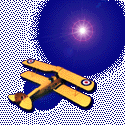

Top Tips, some you may know some you won't, but they all come in useful,
especially if you're new to the hobby!
If
you have any great tips that you want to share with other modellers, then
send them to us at editor@flyingsites.co.uk
or to the address listed on our 'Contacts'
page.
| 3 Blade Props | |
|
3-blade propellers are useful when you have a scale plane that's modeled after a plane that uses them. However, since the engine has more mass to turn, the maximum RPM is lower. The general rule of thumb is to use a 3-bladed prop one inch smaller in diameter than the 2-blade you would normally use. This will allow close to the same maximum RPM as you would have with a 2-bladed prop. You may also increase the pitch by one inch, but experiment and see what works best with your engine and plane.
|
|
| Firewall Fuel Proofing | |
|
Firewalls of planes are normally coated with epoxy to help prevent fuel and oil damage to the wood. On planes with no cowling, apply a coat of epoxy on the firewall after you cover the plane with film covering. Make sure the film overlaps a little onto the firewall. This way the epoxy seals the edges of the film covering. Besides, most film adheres better to wood than epoxy, so that's another plus
|
|
| Ultracote Printing | |
|
Goldberg Ultracote film covering has a paper backing that you can print on. Cut a 8.5 X 11 inch sheet, put it in an inkjet printer, and print your design on the paper backing (don't use a laser printer or anything that uses heat - it'll destroy your covering). This works well for large lettering. Make sure your image is reversed, so that when it's printed on the backing you can cut it out and it'll be correct when ironed on your plane. If you want to use a piece of covering that's smaller, print the design onto paper first. Then carefully tape the Ultracote to the paper over the design. Then run the whole thing through your printer, and the design should print in the same place.
|
|
| Cutting Dowels Straight | |
|
When cutting a dowel, it's easy to make the cut crooked. To help ensure a nice 90-degree end, especially on larger diameters, try rolling the dowel into the bandsaw or scrollsaw blade.
|
|
| Picking Up Glass Safely | |
|
After sweeping up broken glass off your shop floor, it's difficult to pick up tiny fragments. Try making a loop of duct tape, adhesive side out. Place the loop over your hand, and pat the fragments carefully so they stick to the tape. Then just wrap the tape loop in newspaper and put into the rubbish bin.
|
|
| Antenna Holder | |
|
Here's a way to attach a receiver antenna to the back of your plane after it exits the fuselage. Take a short length of fuel tubing and make two cuts into it, dividing it into thirds, but make the cuts go through the tubing only halfway. Then pin the tubing to the top of the plane's fin. Thread the antenna through the tubing, lacing it through the cuts. This will keep the antenna somewhat taught and out of the way of control surfaces
|
|
| Repairing Dings & Dents | |
|
Have you ever had a dent in a balsa leading edge? Try fixing it with water! Get a small syringe and put water in it. Inject a little water into the balsa into and around the dent in the leading edge. Heat the area with your covering iron. When the water starts boiling, it will build pressure and push the balsa out to its original shape. (Courtesy Victor A.)
|
|
| Film Covering Degreaser | |
|
Have you ever wanted to add more film covering (Monokote, Ultracote) to a plane you've already flown? It's difficult to get all the oil exhaust off the plane so the film will stick. Try using Cyanoacrylate (Cyano or superglue) kicker (catalyst). Just spray it on and wipe it off. I've been told it's a very good degreaser. (Courtesy Vince R.)
|
|
| Pulling Oil Out Of Wood | |
|
Sometimes firewalls and engine areas of older planes get soaked with oil from the fuel. This weakens glue joints to the point where a plane could fall apart in midair. Try using Cyanoacrylate (Cyano or superglue) kicker (catalyst). Just spray it on and wipe it off. I've been told it pulls the oil right out of the wood. Several treatments may be necessary. This also works if a fuel tank develops a leak and the fuselage gets soaked with fuel. (Courtesy Jevan F.)
|
|
| Balancing Aeroplanes | |
|
Here's a good way to balance airplanes. While building your plane,
insert a half-inch square piece of plywood where the balance point
should be. For a low wing, this should be on the bottom of the wing,
and for a high wing this would be on top of the wing (Note: sometimes
something will be in the way, like a canopy, and you can't use this
technique). When the plane is finished, put a small hook into the
plywood and suspend the plane with wire or string. This way you
can check the fore-aft balance AND the lateral balance at the same
time (Note: a low wing will be suspended inverted). |
|
| This page has been contributed by Jeff's R/C Airplanes |